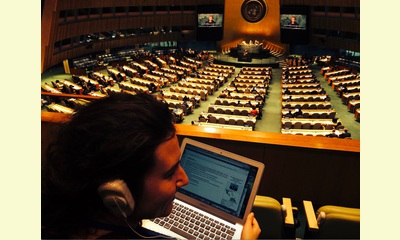|
|
UN General Assembly Approves Language Supporting Unarmed Civilian Protection
un article par Nonviolent Peaceforce
The UN General Assembly (UNGA) today
(December 15) approved a Resolution on Follow-
up to the Declaration of Programme of Action on
the Culture of Peace, A/69/L.34, put forth by
Bangladesh and co-sponsored by over 100
countries. Language noting unarmed civilian
protection (UCP) was contained in the resolution,
marking the first time UCP has been officially
referenced in a UGA Resolution. The resolution
notes: 
Natalie Sikorski, NP Advocacy intern, monitors the General Assembly deliberations on the resolution for the Culture of Peace.
click on photo to enlarge
"...the initiatives of civil society, in collaboration
with governments, to strengthen civilian capacities
to enhance the physical safety of vulnerable
populations under threat of violence and to
promote peaceful settlement of disputes..."
In his introductory remarks, Ambassador Abdul
Momen, the Permanent Representative of
Bangladesh to the UN noted the urgency to build
the Culture of Peace that is the aspiration of all
humanity. “To move away from the chaos and
violence, the Culture of Peace is the answer,” he
urged.
He went on to recognize the strong role of women
in promoting peace and urged that the Culture of
Peace be included in the Post 2015 Sustainable
Development Goals.
In support of the resolution, Ambassador Libran
Cabactulan, the Philippines Permanent
Representative to the UN, observed, “Without
peace there can be no sustainable development,”
Ambassador Cabactulan introduced the GA
resolution A/69/L.41 promoting interreligious and
intercultural dialogue which was considered by
the UNGA at the same time. “Peace can only
come when we have interreligious and
intercultural dialogue. It was at the heart of the
comprehensive agreement signed in the
Philippines last March.” The Philippines mission
played a lead role on the UCP language.
Nonviolent Peaceforce (NP) is proud to have UCP
noted by the UNGA as part of the Culture of
Peace. “It is not a coincidence that NP grew up
during the decade of the Culture of Peace (2001-
2010),” observed NP’s Mel Duncan. “The Culture
of Peace sets the global context for UCP to
develop.”
“This opportunity should be taken advantage of to
elaborate and firmly establish unarmed civilian
protection as part of the Culture of Peace,”
suggested Ambassador Anwarul Chowdhury, the
prime advocate behind the original Culture of
Peace resolutions and founder of the Global
Movement for the Culture of Peace
www.gmcop.org/global-movement. [Editor's
note: the culture of peace resolutions were formulated by
UNESCO and sent to the UN beginning in
1995, culminating in the Declaration
and Programme of Action on a Culture of Peace in
1999. Ambassador Chowdhury became their
advocate at the UN during that time.]
Next steps include having UCP considered by the
UN’s High Level Peace Operations Panel who’s
recommendations are due at the end of April as
well as having UCP further recognized in UNGA
resolutions and the Secretary General’s report on
the Culture of Peace.
|








|
DISCUSSION
Question(s) liée(s) à cet article:
Can peace be guaranteed through nonviolent means?,
* * * * *
Commentaire le plus récent:
We have the advantage of an independent evaluation of the Nonviolent Peaceforce initiative in the Philippines conducted by Swisspeace. The evaluation is very favorable, although in the end, as one reads through it, gets the impression that such initiatives can help but cannot bring peace by themselves.
Here is the executive summary:
Nonviolent Peaceforce in the Philippines can look back at more than two years of unique, relevant contributions and constructive engagement in one of the most difficult, political and volatile, contexts to work in: Being the only international non-governmental organization working with and living in close proximity to the most conflict-affected population in Mindanao, NP in the Philippines was able to support and enhance local structures of cease-fire monitoring, early warning, cross-community dialogues, human rights protection, to offer civilian protection and help to reduce the high levels of community violence.
The accepted offer to NP in the Philippines in late 2009 by the conflict parties GRP and the MILF to join the International Monitoring Team1 (IMT) and its Civilian Protection Component is a direct expression and result of its successful contributions to non-violence and violence reduction of the last two years.
To keep up the important work of NP’s project in the Philippines in the years to come, it is essential to ensure that the activities and objectives of NPP are based on a strategically and conceptually sound footing. This seems even more important given that NPP is going through a remarkable consolidation and expansion phase at the time of report-writing.
The re-focus on its key mandate, strengths and strategic advantages in Mindanao gives NP the opportunity to further enhance its unique work in the area of nonviolence, peacekeeping and peacebuilding.

|
|









